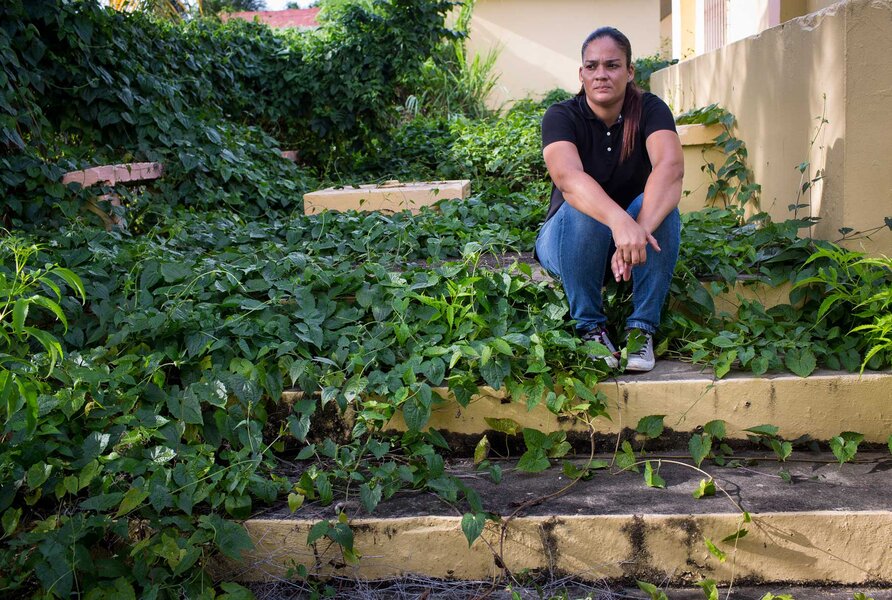Amid Puerto Rico's financial crisis, communities fight to keep schools
Loading...
| Manati, Puerto Rico
Tania Gines Melendez walks around an empty building that once served as both her elementary school and that of her children. Vines and flowering shrubs grow over the sidewalks and a mangy dog gets cozy amid boxes and old worksheets scattered haphazardly on the property.
Jose Melendez Ayala I Elementary School was flourishing just two years ago, Ms. Melendez says. Despite her and other families’ efforts to keep the doors open via a six-month protest, it closed that May. This school, along with about 150 others across Puerto Rico, was part of a rash of closings meant to help the government overcome its sinking budget crisis.
Puerto Rico has been suffering a debt crisis for the past several years, with the island spiraling toward financial default in 2016, when it was unable to pay nearly $370 million in bond payments.
A group of creditors put forward a proposal for how the island could cut its costs, and among the suggestions were a handful of education-specific changes. These include cuts to teacher salaries and higher education spending and school closures. Around the same time, the Department of Education announced a proposal to close 600 of the island’s nearly 1,400 schools in the next five years in an effort to reduce education costs.
“The priority here is not the students,” says Melendez, who sees her school’s closure as a warning to other communities.
Education became a central target for saving money in Puerto Rico, in part because of the island’s declining population. According to data from the Institute of Statistics, there are currently more students graduating from public high schools than there are entering them. Yet, for educators and for those with children attending these schools, the closures are raising red flags about the future of quality and accessible public education on the island.
“We cannot be shutting schools, firing teachers, creating over[crowded] classrooms, eliminating arts, because of the alleged crisis,” says Mercedes Martinez, president of the Federación de Maestros de Puerto Rico, one of two teachers’ unions here, both of which are opposed to the education-related austerity measures.
“People have to be considered before the debt,” she says.
The school closures have created real consequences for families, teachers, union leaders, education officials, and government representatives across the island.
Families say they have received no assistance in reaching their new public schools, which are often further away, despite government promises. The schools also lack vital resources, from computer labs to toilet paper, and many parents take on the maintenance of school buildings amid a lack of government funding.
In Aguas Buenas, a town nestled in the Cayey mountain range, Elba Cardona Diaz now walks her grandchildren two hours round trip to their new school each day because there are no buses. At an elementary school in the eastern municipality of Naguabo, parents question what they will do during the rainy season, when the steep roads become too dangerous to walk to newly assigned schools. And a former high school along the coast, which has a breathtaking view of the ocean from its front steps, is now littered with syringes, straps, and mirrors – telltale signs of the island’s growing drug crisis.
Secretary of Education Rafael Román Meléndez defends the closures. “We closed 150 schools, [but] Puerto Rico should easily have 300 closed schools,” Mr. Meléndez says.
“We are providing transportation for the students,” he counters popular claims otherwise, noting that some schools were kept open over concerns about the increased distance to new locations. Furthermore, few schools have been left vacant, he says. More than 90 percent of the schools closed under his watch are now used by nonprofits, municipalities, or private foundations, he says.
The disconnect between what the government says is happening and what locals see unfolding in front of them has made the topic of school closures even more explosive.
And school closures aren’t the only education reforms working their way across the island: Puerto Rico has, so far, fought off attempts to introduce charter schools to replace low-performing institutions, and is facing a push for more aggressive standardized testing.
Faded protest signs still hang from the chain link fence outside of Jose Melendez Ayala I Elementary School, where parents camped out for six months hoping to halt their school’s closure. One reads, “Community united will never be defeated.”
Some communities, however, have managed to fend off closures by convincing new students to come to their school and boost enrollment.
At Escuela Lutgarda Rivera Reyes Montessori in rural Naguabo, for example, Principal Douglas Melendez says the community successfully had their school taken off the closure list when it decided to bring in a Montessori program.
By implementing “specialized programs there was a great possibility to leave the school open,” Principal Melendez says. Enrollment doubled after the switch, he adds. “The parents [who] decide to bring their child and enroll them in our school, it’s because they want a different educational approach.”
Michelle Kanaar contributed reporting for this story.
A grant funded by The Richard H. Driehaus Foundation and awarded by the Chicago Headline Club helped cover the costs of reporting this story.








